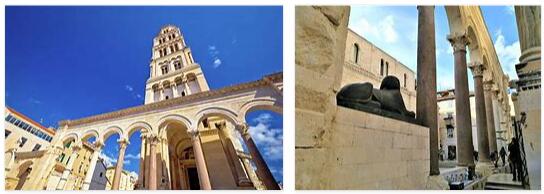The old town is dominated by the remains of the mighty Diocletian’s Palace, which was built between 295 and 305 and was intended as a retirement home for the emperor. He combined various elements from Roman villa and palace architecture or from military and sacred architecture. The current cathedral is part of the former palace, the temple of Jupiter was converted into a baptistery in the 8th century. The old town is a harmonious ensemble of monuments from different epochs, including medieval fortifications and Gothic palaces from the 15th century.
Split: facts
| Official title: | Old town and palace of Emperor Diocletian in Split |
| Cultural monument: | Old town of Split with the retirement home of Emperor Diocletian – side length of the building in the east and west 215 m, in the north and south 180 m, also massive, 2 m thick masonry – the bronze gate (Porta Aenea) and its access to the storage rooms of the palace, the cathedral of St. Domnius (Sveti Dujam) over the emperor’s mausoleum, the temple of Jupiter and palaces such as the Papalić palace |
| Continent: | Europe |
| Country: | Croatia, Dalmatia; See internetsailors |
| Location: | Split |
| Appointment: | 1979 |
| Meaning: | Testimony to Diocletian’s era and an architectural kaleidoscope from Romanesque to Baroque |
Split: history
| AD 295-305 | Palace building of the emperor Diocletian near his birthplace Salona |
| 7th century | Conversion of the temple of Jupiter into the baptistery of St. John |
| 15th century | Construction of the town hall |
| 1420-1797 | Part of the Doge Republic of Venice |
| 1815-1918 | under Austrian rule |
An imperial palace for the people
The Roman emperor Diocletian was tired of office: he, who was venerated as the son of Jupiter, had mercilessly persecuted the Christians in the two decades of his reign without being able to decisively weaken them. He had also tried, with varying degrees of success, to reform his empire and keep it from decline. However, this powerful ruler over almost the entire known world was also a silent nostalgic. After his voluntary abdication in 305 he retired in his home province of Dalmatia and waited for his death. The “imperial deity” had previously had a retirement home built in a bay near Salona.
Diocletian, obsessed with building, did not follow the prevailing zeitgeist: Instead of a villa-like country residence in the taste of the Roman upper class, he had his palace built in the form of a military camp. Even in old age, the former mercenary remained true to his soldier origins. The emperor’s request had caused astonishment in the Roman Empire, but this did not dissuade Diocletian from his endeavor. So he spent his last days protected by thick walls and guarded by mighty towers. The northern part of the complex was intended for the guards and staff, while the splendidly furnished southern part was intended for the emperor and the court. After Diocletian’s death in 313 or 316, the place served as the exile of Roman rulers who were disempowered, and the magnificent building gradually threatened to deteriorate. With the destruction of the Christian-Romanesque city of Salona, only a few kilometers away, by the Avars and Slavs in 614, however, new life came into the palace walls. The refugees of the devastated city saved themselves in the palace and rebuilt it into a new city called Spalato, today’s Split.
Since then, several thousand people have lived tightly packed between ancient columns and walls. Even if some architectural purists do not like the fact that valuable ancient structures have been changed here, it should not be forgotten that this unparalleled ensemble has only been preserved because of the uninterrupted use of the palace – even if for other than the original purposes. Diocletian’s mausoleum was transformed into the cathedral of St. Domnius, an octagonal domed structure. At this point the emperor’s sarcophagus had already been looted and destroyed. The new residents cleverly added further new buildings, such as the walk-in, late Romanesque bell tower with its transparent arcades, into the ensemble, so that the Romanesque, Gothic and Renaissance styles gradually grew on Roman walls.
On the south facade of the palace you can see pillars walled in between windows, which once formed a colonnade behind which the imperial rooms were located. The bronze gate gives access to the interior of the palace and the cellar vaults. If you walk through the cool underground halls, you can see daylight again in the peristyle, in the ancient inner courtyard surrounded by columns. This former cult center has been transformed into an atmospheric cathedral square over the centuries.
Diocletian, whose image, together with that of his wife Prisca, looks out from a round frieze in the dome of his mausoleum, could not have imagined that his tomb would one day become a church for those Christians in whom he saw a danger to his kingdom. It is just as surprising that the old seat of an emperor who was waiting for his death there became one of the liveliest cities on the Adriatic.
